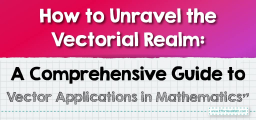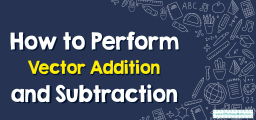Transformation Using Matrices
A vector can be represented as a column matrix. Here you will learn more about using matrices to transform the plane.

The transformation matrix is a matrix that transforms one vector into another vector. The transformation matrix changes the Cartesian system and plots the vector coordinates to new coordinates.
Related Topics
A step-by-step guide to transformation using matrices
An ordered pair \((x,y)\) can be used to represent a vector, however, a column matrix can also be used:
\(\begin{bmatrix}x \\y \end{bmatrix}\)
Polygons could also be represented in matrix form, we simply place all of the coordinates of the vertices into one matrix. This is called a vertex matrix.
Transformation Using Matrices – Example 1:
A square has its vertexes in the following coordinates \((1,1)\), \((-1,1)\), \((-1,-1)\) and \((1,-1)\). Create a vertex matrix.
To create a vertex matrix, plug each ordered pair into each column of a \(4\) column matrix:
\(\begin{bmatrix}x_1 & x_2 & x_3 & x_4 \\y_1 & y_2 & y_3 & y_4 \end{bmatrix}\)\(=\) \(\begin{bmatrix}1 & -1 & -1 & 1 \\1 & 1 & -1 & -1 \end{bmatrix}\)
Transformation Using Matrices – Example 2:
Create a reflection of the vector in the \(x\)-axis. \(v⃗ = \begin{bmatrix}-1 & 3 \\2 & -2 \end{bmatrix}\)
To create a reflection, we have to multiply it by the correct reflection matrix:
\(\begin{bmatrix}-1 & 0 \\0 & 1 \end{bmatrix}\)
So the vertex matrix of our reflection is:
\(\begin{bmatrix}-1 & 3 \\2 & -2 \end{bmatrix}\) . \(\begin{bmatrix}-1 & 0 \\0 & 1 \end{bmatrix}\)
\(=\begin{bmatrix}(-1.-1) + (3. \space0) & (-1. \space 0) + (3. \space 1) \\ (2.\space -1) +(-2 .\space 0) & (2. \space 0) (-2.\space 1) \end{bmatrix}\) \( = \begin{bmatrix}1 & 3 \\-2 & -2\end{bmatrix}\)
Exercises for Transformation Using Matrices
- If \(v⃗ =(2,4)\) and \(?⃗ =(6,2)\). Use matrices to find each of the following vectors:
- \(\color{blue}{3v}\)
- \(\color{blue}{v+u}\)
- \(\color{blue}{u-2v}\)
- Find the new vector formed for the vector \(5i+4j\), with the help of the transformation matrix \(\begin{bmatrix}2 & -3 \\1 & 2\end{bmatrix}\).

- \(\color{blue}{\begin{bmatrix} 6 \\12\end{bmatrix}}\)
- \(\color{blue}{\begin{bmatrix} 8 \\6\end{bmatrix}}\)
- \(\color{blue}{\begin{bmatrix} 2 \\-6\end{bmatrix}}\)
- \(\color{blue}{-2i+13j}\)
Related to This Article
More math articles
- Model Magic: Visualizing Division with Two-digit Divisors
- Top 10 HiSET Math Practice Questions
- The Ultimate NES Elementary Education Math Course
- How to Use Lattice Multiplication Method
- How to Translate Phrases into an Algebraic Statement? (+FREE Worksheet!)
- 5th Grade MCAS Math Worksheets: FREE & Printable
- 5th Grade PARCC Math Practice Test Questions
- 7th Grade MCA Math Worksheets: FREE & Printable
- How to Use Pythagorean Theorem Converse: Is This a Right Triangle?
- 8th Grade ISASP Math Worksheets: FREE & Printable


























What people say about "Transformation Using Matrices - Effortless Math: We Help Students Learn to LOVE Mathematics"?
No one replied yet.